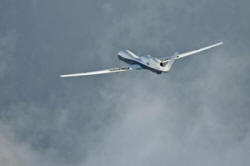|
 U.S.
needs longer-range, stealthy drones: think tank U.S.
needs longer-range, stealthy drones: think tank
 Send a link to a friend
Send a link to a friend
[December 10, 2014]
By Andrea Shalal
WASHINGTON (Reuters) - The U.S. military should
invest more in longer-range, stealthy weapons, and especially unmanned
vehicles, to leverage current advantages and stay ahead of rapid
advances by China, Russia and other potential foes, a Washington think
tank said Tuesday.
|
|
 The report, released by the Center for Strategic and Budgetary
Assessments, acknowledged U.S. budget pressures and said funding for
new weapons could come from base closures, cuts in personnel
benefits and reductions in current modernization programs - such as
the shorter-range Lockheed Martin Corp F-35 fighter jet - and even
aircraft carriers. The report, released by the Center for Strategic and Budgetary
Assessments, acknowledged U.S. budget pressures and said funding for
new weapons could come from base closures, cuts in personnel
benefits and reductions in current modernization programs - such as
the shorter-range Lockheed Martin Corp F-35 fighter jet - and even
aircraft carriers.
Former Navy Undersecretary Robert Martinage, who wrote the report
after spending five years at the Pentagon, said it was meant to
stimulate discussion as part of a major push by the Defense
Department to accelerate technology developments and outpace gains
by other countries.
Representative Randy Forbes, a Virginia Republican and member of the
House Armed Services Committee, told a news conference the report
was a "great first step" toward a more strategic vision for national
defense. He said the current budget cuts and lack of a coherent
strategy meant the U.S. military was "either in or dangerously close
to a crisis."
 Forbes said lawmakers were increasingly concerned about threats to
U.S. military systems, and said he saw a "greater window" to ease
mandatory, across-the-board budget cuts that are due to resume in
2016.
Martinage said adversaries were developing long-range precision
weapons, including ballistic and anti-ship missiles, that could
threaten key overseas facilities and U.S. naval forces, and key
targeting and communications satellites were also more vulnerable
than ever.
To offset those threats, the Pentagon has announced a new drive to
develop new "game-changing" weapons, much as it focuses on nuclear
weapons and long-range delivery systems in the 1950s, and tactical
systems and radar-evading aircraft in the 1970s.
[to top of second column] |

Martinage said the Pentagon should leverage its existing advantages
in the areas such as unmanned systems for air and sea, automation
and robotics, stealth and complex, networked systems, to ensure
continued U.S. military superiority.
He said the U.S. should build a balanced and integrated global
surveillance and strike (GSS) network for initial use in the
mid-2020s would hedge against growing threats to satellites and U.S.
naval assets, while restoring the U.S. military's ability to project
power across the globe.
He said the Pentagon also needed to reform its current bureaucratic
acquisition process and decrease the long times it now takes to
develop and field new weapons.
(Reporting by Andrea Shalal; Editing by Lisa Shumaker)
[© 2014 Thomson Reuters. All rights
reserved.] Copyright 2014 Reuters. All rights reserved. This material may not be published,
broadcast, rewritten or redistributed.
 |